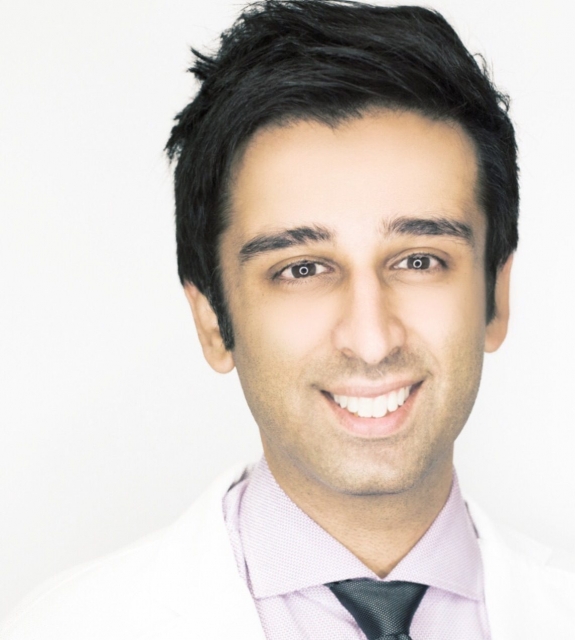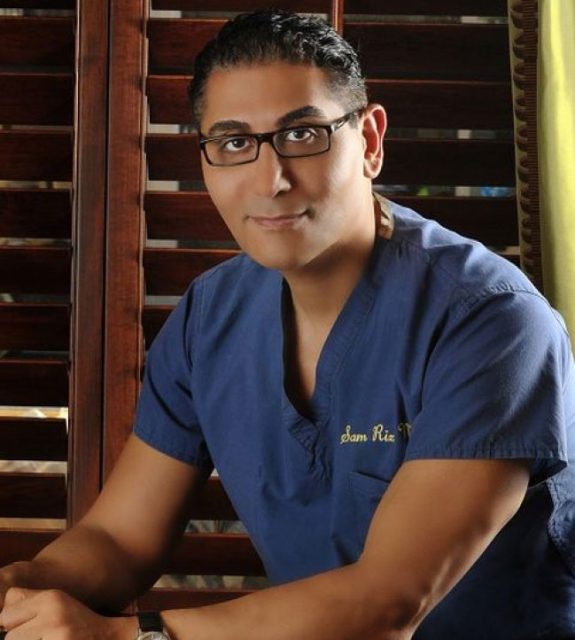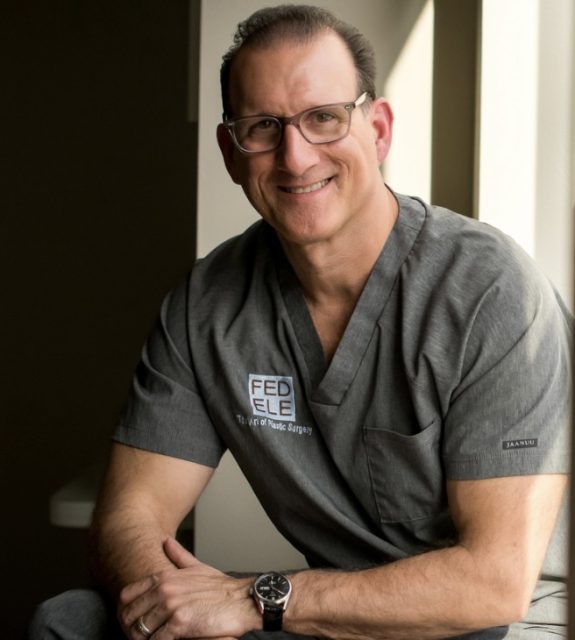
Have you ever wondered why the skin on your neck has been sagging like a turkey's gobbler? Well, this, my friends, is one of the first signs of aging; understandably, it is not ideal for most, which is why we at Haute Beauty got the inside scoop on how you can address your loose skin. Whether surgical or nonsurgical, these are your options, as told by our Haute Beauty experts.
Dr. Paul Durand, Careaga Plastic Surgery | Body | Miami/Fort Lauderdale
Sagging skin on the neck area is extremely common. It can be seen in both younger and older patients. Most patients with this complaint experience facial aging in other places, so it's essential to examine the aging face. Minimally invasive options are sometimes all that is needed to address milder cases of excess skin in the neck. For these cases, a combination of liposuction with skin-tightening technologies can give a great result. For other patients with heavier necks, a well-executed face and neck lift is recommended to address sagging skin in this area. This can yield a very natural, long-lasting result with almost imperceptible incisions.
For more information, visit Careaga Plastic Surgery's website, Instagram, or Facebook!
Dr. Daisy Ayim | Body | Houston
Our practice gets significant monthly consultations to improve jaw/neck appearance. Most clients have recent weight gain that leads to fat deposition in the neck, causing less than ideal image. The treatment solutions to improve neck look are nonsurgical with RF microneedling with Morpheus8, liposuction, necktite which can be performed in combination or individually. The removal of fat deposition with liposuction only can yield fantastic results. Likewise, clients may further have exciting results with the addition of radiofrequency modality to the plan. Facetite (Necktite) is a nonsurgical option that gives impeccable results comparable to a neck lift without a longer recovery time or surgical scar. The surgical option is necklift to maximize rejuvenation with variations of technique or approach. The reasons for turkey neck are weight gain, familial, poor skin quality, medical conditions, and unhealthy lifestyle that promote fat deposition and decrease the strength of the tissue. Fortunately, clients have a variety of options to manage turkey neck.
For more information, visit Dr. Ayim's website, Instagram, or Facebook!
Dr. S. Alexander Earle | Body | Miami/Fort Lauderdale
While turkey is embraced during the holidays, no one wants any part of their body associated with a turkey, especially not their neck. It is very common for both men and women between the ages of 20-70 to complain of unwanted saggy skin in the neck area that can occur from aging and lifestyle choices. As we age, we experience a loss of collagen and skin elasticity, which can cause fat beneath the skin to atrophy, creating a saggy or hollow look in parts of the face called a “turkey neck” – specifically the jowls and neck area. Some patients may want to start with nonsurgical options, such as Gua Sha, creams, facial exercises, and laser techniques to enhance the neckline and reduce the appearance of sagging skin. However, surgery is the only permanent fix. Luckily, there are a few options to correct a “turkey neck” depending on the patient’s skin quality, bone structure, and goals: submentoplasty, a lower rhytidectomy (neck lift) or a facelift.
For more information, visit Dr. Earle's website, Instagram, or Facebook!
Dr. Jeffrey Lisiecki | Nose | New York
I see patients who want to fix their turkey necks all the time! There are so many great options, but it all depends on the cause of the turkey neck in the first place. They can be caused by extra fat, extra skin, or looseness in other structures, like the muscles that generally lend shape and contour to the neck. If you just have a little excess fat in the area, submental liposuction works very well and can be done awake with just local numbing medicine. I often combine this with skin tightening technologies and sometimes jawline filler to really define the neck and jawline. For people with a lot of excess skin, lax neck muscles causing bands, or excess fat in the deeper spaces of the neck, a neck lift or facelift procedure is needed. Sometimes neck lifts can be done with just a small incision under the chin, but for significant skin excess, this means making incisions that hide around and behind the ears to remove extra skin.
I really love a lot of the nonsurgical options for the neck as well. Botox is great for the banding caused by the platysma muscle. If you have horizontal wrinkles in the neck (sometimes called “tech neck” or “necklace lines), certain types of filler can smooth them out. Microneedling and radiofrequency treatments are also fantastic for smoothing and even tightening the skin of the neck.
For more information, visit Dr. Lisiecki's website, Instagram, or Facebook!
Dr. Brian K. Machida | Face | Los Angeles
The majority of my patients have turkey necks since I have a face/neck lift practice. The only remedy which has reliable, excellent results is the face/neck lift with attention to the central neck compartment. Nonsurgical techniques are largely unsuccessful for most turkey necks. They can form from excess skin or muscle or can also form from large muscles or glands in the central compartment.
For more information, visit Dr. Machida's website, Instagram, or Facebook!
Dr. Ira Savetsky | Nose | New York
I see patients every day who desire an improvement in their jawline. Achieving a “snatched” or a very defined jawline often requires a combination of reducing bulkiness around the jaw while augmenting the jaw itself. Older patients often require more invasive techniques, such as a facelift to remove the extra and loose neck skin. This also helps lift and get rid of the jowls. Younger patients can often benefit from less invasive options. The “Nefertiti lift,” masseter neurotoxin, buccal fat pad removal, jawline filler, and liposuction of the neck can all be done in the office and produce excellent results. Energy-based skin tightening technology can also be used in patients with mild to moderate skin laxity.
For more information, visit Dr. Savetsky's website, Instagram, or Facebook!
Dr. Jeffrey Lee | Breast | Boston
The turkey neck is generally another way of saying there is loose skin in the neck area that sags. It is something that happens to everyone over time, and in some unlucky people, it happens earlier than we would like. The solution involves any way to tighten the skin around the neck. Historically the only way to address this was to do a surgical neck lift. Unfortunately, this involved the most downtime, and scars around the ears, and was generally the most expensive route. Now, there are more minimally invasive or even nonsurgical ways of either improving or entirely treating the turkey neck.
My method of choice is FaceTite. This is a form of liposuction that involves the use of radiofrequency energy to tighten the skin. Through the same 3mm access incisions, a cannula is placed under the skin to tighten the skin. This is followed by liposuction to remove the neck fat so you can achieve the best contour. Downtime is minimal, and our patients feel that the neck strap for the first week is the worst part.
If patients want a less invasive option, I recommend microneedling with radiofrequency, or our Morpheus8 treatment. This involves a period of pretreatment with a numbing gel followed by microneedling, which involves tiny needles that go through the skin and deliver a burst of radiofrequency energy to tighten the skin. As with most treatments, the less invasive the treatment, the less effective, so this is generally a great way for turkey necks that are not too bad or those patients who are not a good candidate for Facetite or a surgical neck lift. I generally recommend a series of three or more treatments for the best results. Whichever treatment you choose, it is best to get a consultation to discuss your goals and choose the best option for you!
For more information, visit Dr. Lee's website, Instagram, or Facebook!
Dr. Jose Rodríguez-Feliz | Eyelid Surgery & Face | Miami/Fort Lauderdale
The neck is definitely one of the areas where I have seen improved surgical outcomes over the past decade. This is not so much due to a newer surgical technique but due to a better understanding of the neck anatomy, aging, and the role genetics can play. For example, there is a big difference between the aging neck of a thin, long-neck patient with skin laxity and the bulky neck of a younger patient. The first patient can be treated with some of the most common techniques, such as a face/neck lift with platysmaplasty. On the other hand, some of the younger patients with large bulky necks have deep neck issues that must be addressed such as large deposits of fat deep into the platysmaplasty, large/droopy submandibular glands, and/or hypertrophic digastric muscles. I think more and more patients are looking into surgical options to improve their neck contours.
For more information, visit Dr. Rodríguez-Feliz's website, Instagram, or Facebook!
Dr. Yuly Gorodisky | Brazilian Butt Lift | Oxnard, CA
Every day I meet patients who complain about their sagging neck skin or “turkey neck.” It is probably the most common concern in men and women over 50 and sometimes younger.
The most effective surgical treatment for patients who have saggy necks is a neck lift that reshapes the neck structures, lifts and tightens the neck skin by making incisions around the ears, and removes the excess skin. Some patients may qualify for a less aggressive approach using liposuction, radiofrequency skin tightening, and a neck shaping suture that can be placed through a skin puncture without a large incision behind the ears.
Nonsurgical options are usually not as effective as minimally invasive options. Nonsurgical neck shaping can involve external radio frequency, ultrasound, or radiofrequency micro needling. There are some minimally invasive treatments that can be more effective such as plasma subnormal skin tightening using Renuvion. In combination with a nonsurgical face reshaping, a SurgYlift can give great results without incisions or anesthesia.
There are several factors in the development of saggy neck skin. Skin quality deteriorates as collagen is depleted, and it makes the skin less elastic. Bony structures shrink as we age, which means there is less bony support for the skin and soft tissue structures of the face and neck, causing everything to sag. Some patients who may have been overweight develop excess skin as they lose weight.
For more information, visit Dr. Gorodisky's website, Instagram, or Facebook!
Dr. Samuel Lin | Nose | Boston
Excess tissue and sagging skin beneath the chin, more informally referred to as the “turkey neck," is a common complaint among both male and female patients. Regarding facial aesthetic surgery, the neck region is one of the most common areas in which patients seek treatment.
The sagging appearance of the neck occurs due to changes in the skin, fat, and muscle of the submental region. The skin increases in laxity as more fat gets deposited underneath the chin, and the muscles of the neck become progressively weaker. These changes commonly result from aging but can be made worse by sun exposure and poorly hydrated skin. Genetics is also postulated to play a role. Over time, the angle between the neck and the chin becomes obliterated, forming this characteristic “turkey neck” appearance.
Many patients opt to try nonsurgical options before moving on to more invasive treatments. One option would be injectable Botox, which relaxes the neck muscles that pull down the jawline. Another option is Kybella, an office procedure that targets stubborn fat underneath the chin. While these focus on the muscles and fat, neither of these options adequately treats the sagging skin. Lastly, laser therapy on the skin can result in a more tightened, lifted appearance to the neck.
The first option potentially would be liposuction, which is more minimally invasive than other surgical procedures. Liposuction can target and remove the excess fat in the submental region, giving the neck a slimmer appearance. Alternatively, a neck lift is a more invasive surgical procedure that can thoroughly address each of the underlying issues of the neck skin, fat, and muscle with an incision behind the chin area. These procedures allow for the most dramatic and long-lasting results.
For more information, visit Dr. Lin's website, Instagram, or Facebook!
Dr. Robert Vitolo | Breast | New York
Most people after the age of 30 have some sort of a double chin and are starting to develop jowls. Now, that’s not a turkey neck but that’s what most people have. A turkey neck is most commonly on someone who is in their 60s, who’s lost a lot of weight, and when you lose weight, you lose it in your face first, and that lets everything hang. A turkey gobbler is when the skin is hanging down like a pouch. Now, that operation usually requires one of two surgeries.
One surgery, and probably the most definitive, if it is a really bad turkey gobbler, is a neck lift, where we make an incision in front and behind the ear. We remove the excess fat, and then we pull the skin back and re-drape it on the neck. Now, that’s like the bottom half of a facelift. So, the incisions are pretty much the same for the neck lift and the full, conventional facelift. The difference is that there’s another inch and a half of scar upwards, above the ear. So, most people that are going to do that must have a facelift done because they need it at that point. If you have a turkey gobbler, you need a facelift.
Now, for people that don't have as bad of a gobbler, that can be removed with minimally invasive liposuction of the jowls and the fat underneath the chin. Now, if you remove the fat, and they have a semi-turkey gobbler, and there’s extra skin, you just can’t leave that skin there because that skin will contract like a band. So, in that case, we do what’s called a sling, which is a very simple procedure to tighten and lift the skin.
For more information, visit Dr. Vitolo's website, Instagram or Facebook!
























